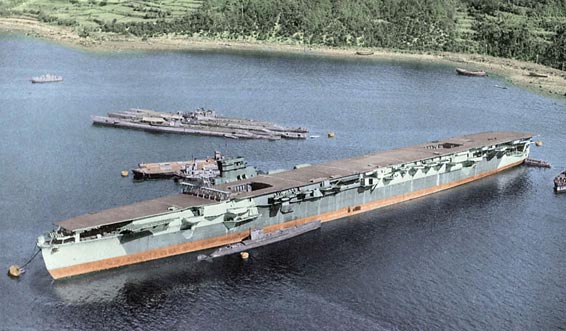
The Unryu class represented a step back in Japanese carrier quality, and the Imperial Japanese Navy abandoned its hopes of producing further carriers of the Taiho’s excellence.
The search for qualitative excellence was demonstrated by the Taiho, which combined the performance and aircraft capacity of the Shokaku class (the epitome of Japanese prewar design) with greatly enhanced protection, while the demand for quantity production was exemplified by the Unryu class and the Imperial Japanese Navy’s very extensive “shadow” carrier fleet. The limitations of Japan’s industrial base made this an impossible task. Most of the “shadow” carrier designs required major qualitative concessions of speed, aircraft capacity, or protection that limited their contribution to carrier task force capabilities.
Design: This design evolved from that of the Soryu with heavier 5.9-inch side armor protection for the magazines and only two elevators. Shortages led to the installation of 100,000 shp destroyer plants in the Katsuragi and the Aso, reducing their speed by two knots. The full Japanese carrier radar suite of two Type 21 and one Type 13 sets was installed. Two additional vessels were never laid down. Modifications: The light antiaircraft battery was increased to twenty-two triple 25mm mounts and twentythree single 25mm mounts, plus six 28-tube 120mm rocket launchers.
Service: The Kasagi, the Aso, and the Ikoma were never completed and were scrapped after World War II. The Katsuragi was damaged at Kure by aircraft bombs on March 19 and July 28, 1945, and never commissioned. It was used as a repatriation transport from August 1945 until November 1946, and then broken up at Osaka in 1947. The submarine Redfish torpedoed and sank the Unryu on December 19, 1944, southeast of Shanghai. Aircraft from Task Force 38 damaged the Amagi at Kure on March 19, 1945, and sank it on July 24. The wreck was raised and scrapped in 1947.